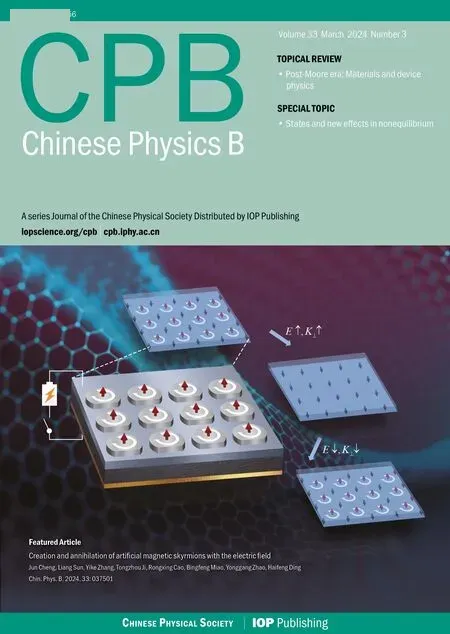Real eigenvalues determined by recursion of eigenstates
Tong Liu(刘通) and Youguo Wang(王友国)
School of Science,Nanjing University of Posts and Telecommunications,Nanjing 210003,China
Keywords: real eigenvalues,non-Hermitian,quasiperiodic
1.Introduction
In the traditional textbooks about quantum mechanics,the operator representing an observable is typically assumed to be a Hermitian operator,which has real eigenvalues.[1]However,with the breakthrough of quantum theory and the development of experimental technology,[2-4]there are several models of open quantum systems in which non-Hermitian Hamiltonians with complex eigenvalues make perfect sense, and both the real and imaginary parts of them are needed to reproduce the measured absorption and emission spectra.[5,6]In fact, it is nowadays well understood that having real eigenvalues is a property of the Hamiltonian related to conservation of the total probability,[7]rather than physical observability.
However,the lifetime of a particle in non-Hermitian systems is considered to be short due to the imaginary part of the eigenvalue during a dynamical evolution.Therefore,non-Hermitian systems with pure real energy spectra are particularly valuable.The emergence of parity-time(PT)symmetry class[8,9]provides such a paradigm,and formulates an alternative theory of quantum mechanics in which the mathematical axiom of Hermiticity is replaced by the physically transparent condition.Fascinatingly,if the Hamiltonian possesses unbrokenPTsymmetry,the eigenvalues are exclusively real.Hence thePTsymmetry class describes a class of non-Hermitian systems having conservation of the total probability and unitary time evolution.
A question arises naturally: Is there another physical mechanism for generating the real energy spectrum[10-12]of non-Hermitian systems? Massive research enthusiasm has being devoted to unveiling the new non-Hermitian class.[13,14]In this work, we attempt to revealing a new mechanism for real energy spectra of non-Hermitian systems,the core idea is that the recursion of eigenstates of the Hamiltonian can constraint the eigenvalues to be the real or complex numbers.In fact, there are many paradigms in quantum mechanics textbooks demonstrating that the properties of eigenstates have indeed great influence on eigenvalues.For example, in the eigenvalue problem of the quantum harmonic oscillator,it can be proved that the Hermite equation has a polynomial solution (Hermite polynomial), namely the wave function is represented asφ(x)=∑∞n=0anxn.The recurrence relation of the coefficient.The problem is that the solution of eigenstatesφ(x) will inevitably lead to divergence in largexlimit,so the truncation must occur for the recursive relation ofan.The most straightforward way is to set the numerator to zero, namely 2n+1-E=0.This leads toE=2n+1,which means that eigenvalues are taken as discrete values rather than continuous values in classical physics.
Analogy to the quantum harmonic oscillator model, the discretization of eigenvalues is constrained by the recursion of eigenstates, it is reasonably deduced that there exists a class of models in which the eigenvalues to be the real or complex numbers can be determined by the recursive relation of eigenstates.The rest of the paper is organized as follows: In Section 2,we theoretically demonstrate in detail how the properties of eigenstates determine the real or complex eigenvalues through a simple model.In Section 3, we validate the theoretical results through numerical simulations.In Section 4,we provide some prospects for more models, and point out that eigenvalues determined by the recursion of eigenstates hold in general.In Section 5,we make a summary of this study.
2.Model and real eigenvalues
Several numerical results indicate that non-Hermitian quasiperiodic systems[15,16]also exhibit pure real energy spectra within a certain parameter range,but the relevant physical mechanisms and interpretations are still unclear.For instance,a p-wave superconducting system with a complex quasiperiodic potential[17]does not involve thePTsymmetry,however,the eigenvalues of extended states are still pure real.While the eigenstates of the system become localized, the eigenvalues become complex.By exactly solving the Lyapunov exponent of a modulated complex quasiperiodic system,[18]it is found that there is a relation between the eigenvalue and the Lyapunov exponent.When the system is in an extended state,the imaginary part of its eigenvalue is suppressed at the thermodynamic limit.
However,a complete and clear explanation for such phenomena is still lacking.This work attempts to clarify the underlying physical mechanism through a simple model.Simplicity means that the solution does not require complicated mathematical skills, more relevantly, it can be regarded as a paradigm to grasp the physical picture intuitively.Previous efforts[19,20]have been made to numerically and semianalytically solve this model,whereas we attempt to obtain the eigenvalues in an analytical sense.The difference Schr¨odinger equation of the system can be written as
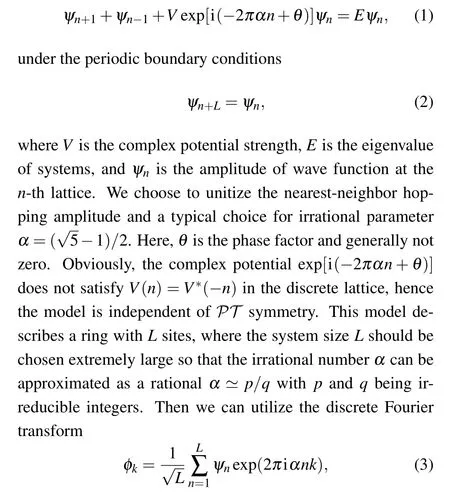
the eigenvalue equation (1) can be transformed into the momentum space,
there is a multiplying factor exp(iθ)in the termφk-1,however this factor is readily suppressed under the gauge transformationφk →exp(ikθ)φk.
According to Eq.(4),an initial wave function solution can be written as
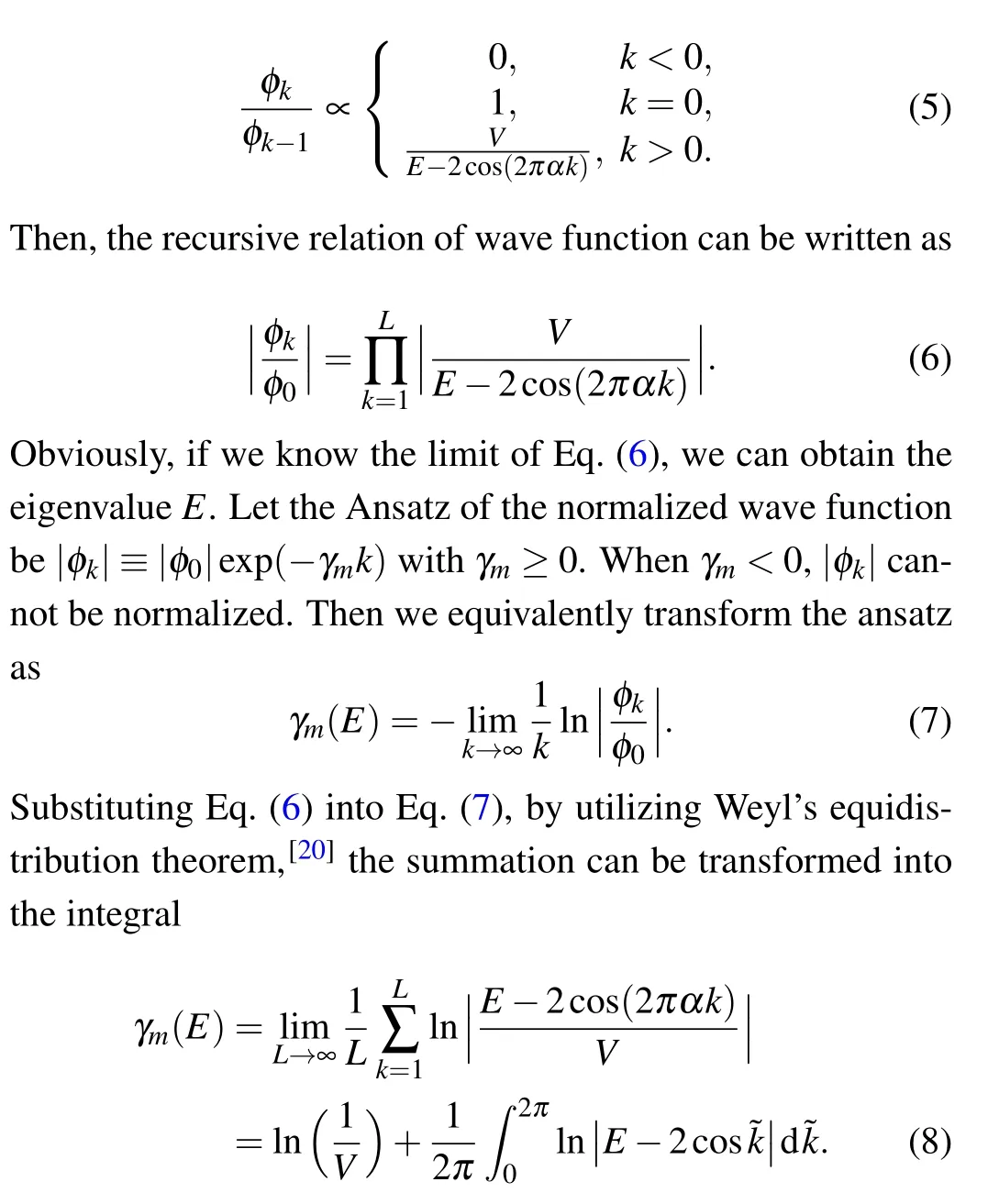
Obviously, to obtain the eigenvalueE, we need to know the value ofγm.In fact,γmhas the explicit physical significance,which is Lyapunov exponent, originating from the Hamiltonian in momentum space.
To obtainγm, we can utilize a famous formula, which has been obtained initially for random systems by Thouless and can be used without any change for non-random systems.Namely, Lyapunov exponent can be related to the density of states by
which is dubbed Thouless formula.[21]For non-Hermitian tight-binding lattices with nearest-neighbor hopping,provided that the hopping amplitudes are symmetric, a similar relation can be established.[20]The advantage of this formula is able to connect Lyapunov exponent in position spaceγand Lyapunov exponent in momentum spaceγm.The definition of density of states is the number of quantum states with energy ranging fromEtoE+ΔE.Under Fourier transform, the eigenvalues of Eqs.(1)and(4)remain unchanged.Hence Eqs.(1)and(4)have the same density of state

From Eq.(11), if we obtainγ,γmcan also be naturally obtained.
As regard toγ, we refer to the transfer matrix method,which can be used for the analysis of the wave propagation in classical or quantum systems.The growth or decay of the propagation is governed by the Lyapunov spectrum of the product of transfer matrices.For the one-dimensional nearest-neighbor hopping model, the transfer matrix is twodimensional, the nonzero or zero values of Lyapunov exponents are utilized to measure whether waves are localized at a certain location or spread throughout the entire space.The specific transfer matrix of Eq.(1)can be written as
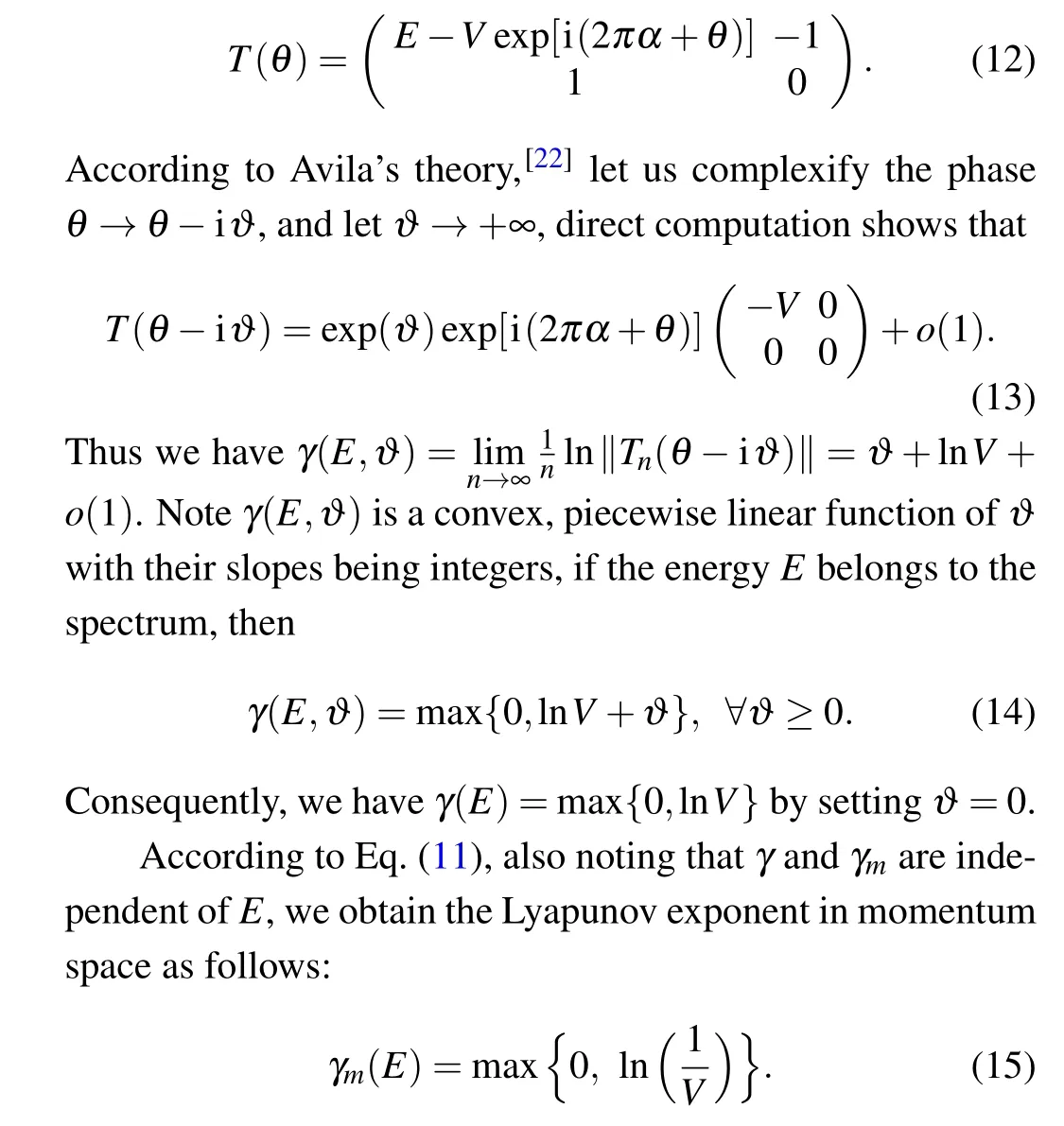
It is obvious that, whenV <1, the real space Hamiltonian is in the extended phase, whereas the momentum space Hamiltonian is in the localized phase; whenV >1, the real space Hamiltonian is in the localized phase, whereas the momentum space Hamiltonian is in the extended phase.It should be emphasized that Lyapunov exponent cannot directly give the information of eigenvalues, taking any value ofEto satisfy the formulaγ=lnV,however,the eigenvalue of the system is certainly not arbitrary.

with 0≤˜k <2π.This result has important physical consequences, it means that when 0<V ≤1, all eigenvalues are real numbers.
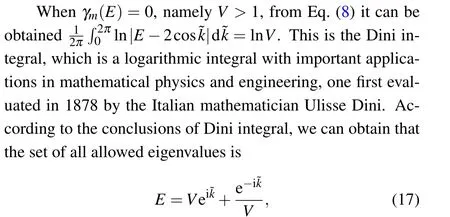
with 0≤˜k <2π.At the phase transition pointV=1, two sets of eigenvalues can be connected smoothly.In the above derivation,we focus on the integral equation of the Lyapunov exponent in the momentum space, essentially the recursion of eigenstate in the momentum space, to determine the value range of eigenvalues.
3.Numerical verification
To support the above analytical result,we now present the numerical verification, namely directly diagonalize Eq.(1)to obtain the eigenvalues and eigenstates.In Figs.1(a)and 1(b),numerical results under periodic boundary conditions demonstrate that when the potential strengthV <1, all eigenvalues of the system are filled in intervals[-2,2],therefore,they are pure real.Thus, the conserved evolution probability of the system is guaranteed,just as thePTunbroken system.WhenV >1, as shown in Figs.1(c) and 1(d), the imaginary part of eigenvalues is no longer limited to 0, whereas the real and imaginary parts form a closed loop, satisfying the expression
Considering non-Hermitian skin effect,[13,14]real energy spectra can be induced by open boundary conditions, we further perform the numerical simulation for Eq.(1)under open boundary conditions.As shown in Figs.1(e)and 1(f),and as compared to Figs.1(a)and 1(d),the energy spectra remain unchanged under both the boundary conditions, which demonstrates that the eigenvalue problem of Eq.(1) is independent of non-Hermitian skin effect.Thus, all numerical results are completely consistent with the theoretical predictions, which confirm the validation of our theory.

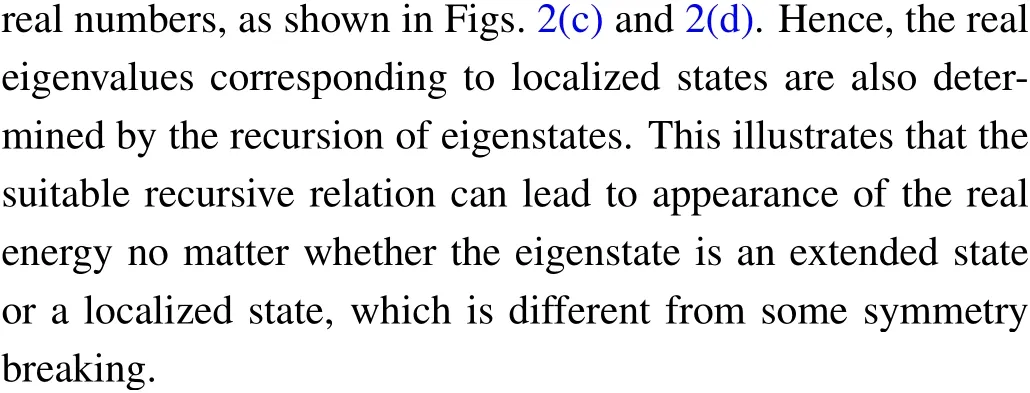
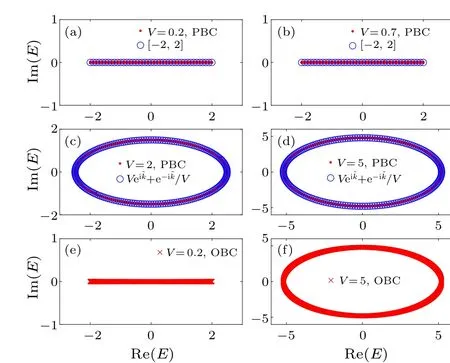
Fig.1.The eigenvalues of Eq.(1)are illustrated,the abscissa is the real part of the eigenvalues,and the ordinate is the imaginary part.The total number of sites is set to be L=2000.The red dots represent the numerical solutions under periodic boundary conditions, the blue circles represent the theoretical values, and the red crosses represent numerical solutions under open boundary conditions.As shown in(a)and(b),when V <1,the system host the pure real energy spectrum[-2,2].When V >1[(c)and(d)],the energy spectrum of the system forms a closed loop,and the numerical solutions are in good agreement with the theoretical predicted values.As shown in (e)and(f),the spectra are not affected by the boundary conditions.

Fig.2.The absolute value of eigenstates of Eq.(1) under periodic boundary conditions for typical eigenvalues.The total number of sites is set to be L=2000.Here, (a) and (b) demonstrate that the general real eigenvalues correspond to extended states when V <1;(c)and(d)demonstrate that some special real eigenvalues correspond to localized states when V >1.
4.Prospect in more models
In fact, real eigenvalues in many complicated models[23-25]also originated from the recursion of eigenstates.However, due to the complexity of models, obtaining rigorous mathematical solutions is very difficult.To illustrate the generality of the framework,we briefly introduce two models,and discuss some semi-analytical solutions.
Firstly, we introduce the following difference equation:[25]

Unfortunately,due to the complexity of this model,we are unable to obtain the explicit expression ofγmthrough Thouless formula.Alternatively,we makeγ(E)=0,and obtain thatEis within the region[V-2,2-V];we makeγ(E)>0,and obtain thatEis within the region{iy|y ∈R*}(V ≤2)or{iy|y ∈R}(V >2).Then,we substitute these guessed energies“E”into Eq.(20), and find that whenE ∈[V-2,2-V],γm(E)>0,whileEis a pure imaginary number,γm(E)=0, all detailed calculations can be found in Ref.[25].Since the energyEexactly satisfies the duality relation (γ=0,γm >0 andγ >0,γm=0)indicated by Thouless formula between Lyapunov exponent in position space and momentum space,we conjecture thatEis the eigenvalue of Eq.(18).
In addition to quasiperiodic models,real eigenvalues determined by the recursion of eigenstates is also applicable to random disordered systems.A paradigm of non-Hermitian random disorder is the Hatano-Nelson model,[26]which originated from the study of the pinning of flux lines by random columnar defects in a superconductor.In the clean limit(no random impurities), the model is well known as the non-Hermitian skin effect due to the imaginary gauge fieldh, the eigenvalues form an ellipse on the complex plane under periodic boundary conditions, and the corresponding eigenstates are extended.With increase of concentration of random impurities, real eigenvalues emerge at the edge of spectra and the corresponding eigenstates are localized, while complex eigenvalues at the center of spectra also correspond to extended eigenstates.On the surface, it seems that the Hatano-Nelson model violates the principle of real eigenvalues corresponding to extended eigenstates for quasiperiodic models.Actually,numerous works in physics community[27]have shown that the emergence of real energy spectra still stems from Lyapunov exponent of the eigenstate for the Hatano-Nelson model.Unfortunately,a complete and rigorous calculating result is still missing.Nevertheless,some mathematical references[28]demonstrate that the behavior of the eigenvalues depends crucially on the Lyapunov exponent associated to the Hermitian operator.The mathematical skills of relational papers are quite advanced, and we directly quote their conclusions.Making the potential of random impurities has the uniform distribution[-1,1],there exist two critical values 0<h1<h2and the following hold: (i)when 0≤h <h1,the eigenvalues of Hatano-Nelson model are totally real;(ii)whenh1<h <h2,some of the eigenvalues remain real,while others form a smooth curve on the complex plane;(iii)whenh2<h,all eigenvalues become complex.An intuitive understanding is that when the imaginary gauge fieldh=0, the system is the Hermitian-Anderson model,and the eigenvalues are pure real accompanied by localized eigenstates.Whenhgradually increases,the eigenvalues corresponding to the localized state remain real,nevertheless,the complex eigenvalues induced by non-Hermitian effect correspond to the delocalization of the eigenstates.Thus,the recursions of eigenstates are still closely linked with eigenvalues.
5.Conclusions
In summary,we provide analytically an example of pure real energy spectrum originated from the recursive relation of eigenstates,which is different from the known physical mechanism,such as thePTsymmetry.As long as the recursion of the eigenstate is determined,the eigenvalue of the system may have a pure real energy spectrum, which means that the system can undergo unitary time evolution.In addition,we need to emphasize that extended states of the system lead to the real eigenvalues in most cases,however,this is not a necessary condition for the eigenvalue to be a real number,and localized states can also produce the real eigenvalues.Finally, we provide the prospect that eigenvalues determined by the recursion of eigenstates are widely present in various systems.Our discovery of this non-Hermitian phenomenon promotes the realm of the eigenvalue problem in non-Hermitian quantum theory towards a new avenue,and these findings are expected to be of great interest to the broad community.
Acknowledgments
This work was supported by the National Natural Science Foundation of China (Grant No.62071248), the Natural Science Foundation of Nanjing University of Posts and Telecommunications (Grant No.NY223109), and China Postdoctoral Science Foundation(Grant No.2022M721693).
- Chinese Physics B的其它文章
- A multilayer network diffusion-based model for reviewer recommendation
- Speed limit effect during lane change in a two-lane lattice model under V2X environment
- Dynamics of information diffusion and disease transmission in time-varying multiplex networks with asymmetric activity levels
- Modeling the performance of perovskite solar cells with inserting porous insulating alumina nanoplates
- Logical stochastic resonance in a cross-bifurcation non-smooth system
- Experimental investigation of omnidirectional multiphysics bilayer invisibility cloak with anisotropic geometry

